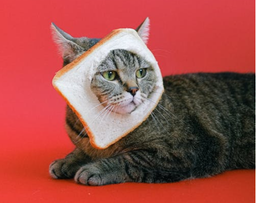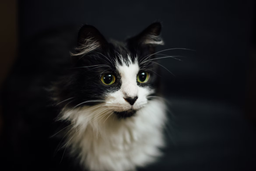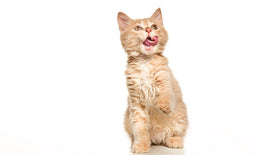Can cats eat oranges? Get to the “juicy details” of feline nutrition with Untamed
A glass of freshly squeezed OJ is the perfect way to start your day. Besides being utterly delicious, the tropical fruit is an excellent source of vitamin C and fibre. But, can you share your morning routine with your feline companion, or are there some health concerns to consider?
In this article, we answer the “can cats eat oranges” query while looking into the dos and don’ts of feline nutrition. We’ll explain why the citrusy treat isn’t cat-safe and point out other problematic foods your pet should avoid.
Can cats eat oranges?
No, cats cannot eat oranges, at least not without consequence. Like other citruses, the fruit contains substances toxic to felines, such as:
- Essential oils—While essential oils provide the pleasant “citrusy” smell of oranges, they also cause skin inflammations in felines. The limonene and linalool in citrus rinds can provoke acute dermatitis, especially in allergy-prone breeds (e.g. Bengal and Siamese cats) through touch alone. Essential oils can affect the feline’s central nervous system as well, causing mood swings, trembling, and even seizures
- Citric acid—Citric acid is what gives oranges their signature tart flavour. It’s also one of the reasons why cats should stay away from the fruit. Felines are extremely sensitive to the substance, and ingesting it can cause immediate gastrointestinal problems (e.g. vomiting and diarrhoea). Oranges have approximately 11% of citric acid, which is enough to give your pet an upset stomach, particularly if they’re prone to digestive disorders
- Psoralens—Oranges contain psoralens and furocoumarins—chemicals that can cause photosensitivity in felines. Cats who develop the condition are extremely sensitive to sunlight, often suffering from sunburn-like injuries (e.g. redness and swelling). The discomfort causes them to claw at their skin, especially the ears, eyelids, and other exposed areas

Can cats eat oranges? No dice (or rather no slice!)
Source: Jeremy Bezanger
What should I do if my cat eats an orange?
Luckily, oranges aren’t as a-peel-ling to felines as other problematic foods because most of them dislike the zesty smell of citruses. If you do catch your cat nibbling, sniffing, or licking an orange, watch out for the following signs of citrus poisoning:
- Vomiting or dry heaving
- Diarrhoea
- Increased salivation
- Lethargy
- Dermatitis
- Depression
- Muscle tremors
As soon as you notice the signs, take your cat to the vet for further diagnosis. Tell the vet when the symptoms started, and describe the events leading to your visit (e.g. your pet eating an orange).
It’s difficult to recognise citrus poisoning without the information since gastrointestinal distress, weakness, and skin inflammations can be attributed to other afflictions (e.g. bacterial infections, chronic illness, etc.). Your vet will most likely use an endoscope to examine your cat’s stomach cavity and confirm food poisoning.
Remember, cats can have severe reactions from merely grazing the rinds, so don’t exclude it from your report. Also, various household items, such as hand creams, detergents, and perfumes, contain essential oil extracts that can cause citric toxicosis.
Citrus poisoning—treatment and recovery
Depending on how your cat got citrus poisoning, the treatment and recovery process can vary. In case of allergic dermatitis caused by contact with the fruit, the vet will have to bathe your pet to remove the toxins from their skin. If the skin is blotchy and swollen, they’ll most likely apply topical corticosteroids to the irritated areas.
Cats who have ingested the toxins and are experiencing digestive problems go through a slightly more invasive procedure. They will most likely be given a 3% hydrogen peroxide solution to induce vomiting or a full stomach flush (i.e. gastric lavage) to get rid of the toxins. The vet may also prescribe some active charcoal to swipe up any remains of the irritable substances.
After the treatment, your cat may suffer from dehydration but will otherwise fully recover. Citrus poisoning is rarely lethal, although some felines are more vulnerable than others. Elderly cats and kittens can experience more severe reactions after eating oranges since they have weaker stomachs than healthy, fully-fledged felines.

Are you glad you caught me before I ate the whole tree?
Source: Lizzie George
Are there more fruits and veggies that are toxic to cats?
Besides citruses, your cat shouldn’t eat:
- Grapes—Grapes and grape byproducts are toxic to both cats and dogs, although the exact cause is elusive. Nutritional experts suspect that the fungal toxins in the fruit are behind the intolerance, but it could also be the presence of tartaric acid. If your cat eats grapes or raisins, they can develop acute kidney disease. The majority of breeds popular in the UK are susceptible to renal diseases, like Persians, Ragdolls, and Maine Coons
- Allium plants—Onions, garlic, chives, and leeks belong to the allium family of plants that are harmful to cats. The veggies contain oxidants that destroy the feline’s red blood cells at a much faster rate than desirable. Cats who regularly eat allium plants can become anaemic, especially if they have a genetic predisposition for the disorder, like the Abyssinian cat. The accelerated hemolysis (i.e. red blood cells breakdown) prevents efficient oxygen distribution and can cause fatigue, vertigo, abnormal heartbeat, poor circulation, and severe chest pain
Which fruits and veggies are cat-safe?
Most fruits and veggies won’t harm your pet. When given in moderation, vegetarian snacks might be good for their gut, according to some experts. The soluble fibre content in fresh produce may have a soothing effect on the abdomen and can even assist digestion, although the benefits are yet to be confirmed. In case your cat’s struggling to poo, half a tablespoon of mashed pumpkins might do the trick.
Check out the table below for some more high-fibre fruits and veggies that are cat-safe:
|
Fruits |
Veggies |
Plants and fungi |
|
|
Do cats need to eat fruit at all?
Your pet may enjoy a rare “fruity” treat, but they don’t have a biological need for it. Cats are obligate carnivores who can’t absorb essential nutrients—mainly protein—from veggies, fruits, or other plant-based sources. An adult feline of an average weight requires at least two meat-based meals per day to function properly. Other foods should be handed out as treats or entirely removed from the menu (case in point—oranges).
A predominantly vegetarian diet is also high in carbs, a nutrient that doesn’t mix well with carnivores. Cats are biologically adapted to survive on animal protein alone, so they lack the digestive enzymes for processing high amounts of sugar and fibre.
If you stuff your pet with fruits and veggies, they can develop:
- Gastrointestinal problems—Natural occurring sugar, like fructose and glucose, can upset your cat’s stomach and cause them to throw up. When serving fruits and veggies to your pet, slice them into tiny bite-sized pieces to prevent indigestion
- Chronic dehydration—Soluble fibre is a complex carbohydrate that absorbs water as it passes through the digestive system. Cats who have too much fibre in their diet can quickly become dehydrated and get bladder stones or other urinary tract problems
- Obesity—Felines can’t utilise the excess carbs for energy, so they’re left with a calorie surplus. The recommended daily allowance for indoor cats is about 40 calories per kilo—anything beyond could lead to an unhealthy weight gain
- Metabolic disorders—An imbalanced diet can contribute to the onset of diabetes and other metabolic disorders, particularly if your cat has the genes for it

Let them eat meat!
Image (c) Untamed
What’s the perfect diet for my carnivorous cat?
The feline’s natural diet is exclusively carnivorous—a biological fact that hasn’t changed in millennia. Your cat needs meat-based meals that are naturally high in animal protein and low in carbs.
Animal protein is the crux of feline nutrition, delivering essential amino acids, like taurine, that keep your pet healthy. Wild cats get it from the tissue and organs of freshly slaughtered prey, but your stay-at-home cat has to rely on you to put food on the table.
Which diet provides the ideal nutrient ratio for felines? Let’s look at the three most widespread meal plans, namely:
- Raw food
- Dry food
- Wet food
Raw food
While the “bones and raw food” (B.A.R.F.) diet seems like the logical choice for your pet, you should be aware of the potential health risks. Unprocessed foods, like uncooked meat, raw eggs, and unpasteurised milk can contain food-borne pathogens that cause life-threatening infections in cats.
If your cat eats raw food regularly, they can be exposed to:
- Salmonella—Present in raw pork, fish, beef, chicken and other meat, raw eggs, and unpasteurised milk
- Listeria—Found in raw meat, raw eggs, and unpasteurised milk
- E. coli—Present in raw or undercooked meat and breast milk (from a contaminated cat)
- Roundworm—Found in raw pork and eggs
- Tapeworm—Present in raw pork or venison
The typical signs of bacterial and parasitic infections include high fever, digestive problems (e.g. vomiting and diarrhoea), and lack of energy. Contaminated cats can go weeks without showcasing any symptoms while spreading the microbes to other members of the household. Kittens, elderly cats, and felines with compromised immune systems are more likely to succumb to infections.
Store-bought raw meals are a safer alternative to homemade raw food, but studies have shown there are still causes for concern. For example, not all raw food manufacturers adhere to safety standards, so there’s still a possibility of bacterial contamination.
Note: Keep in mind that common garden pests like mice and slugs can also carry microbial pathogens.
Dry food
In contrast to raw food, dry products are heavily processed. The ingredients are mixed together to form a paste-like dough, which is then exposed to extreme heat and pushed (i.e. extruded) through a die cutting machine. The extrusion process drains the moisture from the dough and gives kibble its recognisable shape and texture.
Although dry food is made with ground meat, it almost always includes veggies (mostly soybean meal) and starchy foods, like rice, cereal, corn, and other grains. Various plant-based fillers increase the carb content in kibble and add to the overall calorie count.
Because of the excess carbs, a dry-food-only diet raises a few red flags. If you have a cat that’s prone to diabetes, obesity, and other metabolic disorders, they shouldn’t feed on biscuits alone. The lack of moisture is another minus since water aids digestion, circulation, and nutrient absorption in mammals. If your pet is keen on kibble, you should serve it in combination with wet food, or they might become dehydrated.
Wet food
High-quality semi-wet and wet products have all the nutritional properties of raw meat without any safety concerns. Before being cooked at an industry-mandated temperature, wet food ingredients are hermetically sealed in a tin or pouch. The process ensures the final product is free of microbial pathogens and highly nourishing.
Top-notch wet food is less caloric than kibble since it doesn’t contain starchy foods. Some recipes have grain listed as an ingredient, but the carb percentage is nonetheless low.
A wet-food-only diet is:
- Rich in animal protein and amino acids
- High in moisture (78%)
- Filled with natural vitamins and minerals
The high moisture content is one of the biggest advantages of wet meals since most cats struggle to remain hydrated. Another upside is the assortment of tastes and textures. A cat who has shredded chicken for breakfast and seafood in gravy for supper has no cause for fussiness!
Untamed—the best diet for your meat-eating pet

Who wants apples and oranges when you can have tins, and tins, and tins of cat food?
Image (c) Untamed
Untamed food is carefully formulated with your cat’s carnivorous nature in mind. We work hard to provide the ideal nutrient ratio in each delicious serving. Our products are:
- High in protein—A tin of Untamed food has double the protein than most other commercially available products
- Made with whole meat—Our meat is of human-grade quality, so the flavour is entirely natural—we don’t use additives or animal derivatives
- Vet-formulated—Each recipe is formulated in collaboration with vets with the goal of designing the ultimate feline diet
- Ethically produced—Untamed food is made with sustainably caught meat and dolphin-safe tuna
- Impossible to resist—Our recipes are fussy eater approved! Your picky furry friend won’t resist Untamed’s renowned feline delicacies
What makes Untamed the ultimate feline diet?
The fresh and natural ingredients are gently steamed to lock in the bioavailable nutrients. All Untamed products are made with high-quality poultry and fish cuts, including:
- Chicken breast
- Duck breast
- Chicken liver
- Salmon fillet
- Tuna steak
- Sardine and mackerel fillet
- Shrimp
Besides being completely irresistible, our specially formulated cat food can improve your pet’s quality of life. Members of the Untamed clowder have noted significant changes in their cat's digestive health, as well as other advantages:
|
Timeline |
Health benefits |
|
Within a week |
|
|
After two months |
|
|
Within four months |
|
|
Life-long benefits |
|
Check out our amazing recipes!
Take a brief online quiz and create a customised menu based on your cat’s preferences and food sensitivities. Untamed products come in both gravy and jelly variants, with many exciting recipes:
- Chocka Chicken in Jelly—Extra moist chicken breasts soaked in jelly
- Tuck-in Tuna in Jelly—Dolphin-safe tuna simmered in appetising fish broth
- Chocka Chicken with Duck in Jelly—High-quality chicken breast mixed with whole duck meat, served in delicious jelly
- Tuck-in Tuna with Salmon in Jelly—Tuna steak soaked in jelly and served with high-quality salmon fillet
- Chocka Chicken in Gravy—Shredded chicken breast simmered in natural gravy
If your cat is extra sensitive, feed them our single-protein-source recipes—Chocka Chicken in Jelly and Tuck-in Tuna in Jelly.

Untamed’s Tuck-in Tuna in Jelly is a well-loved single-protein-source recipe.
Image (c) Untamed
Sign up for a starter pack!
You can order our premium cat food online with no-cost shipping. Sign up for an Untamed tester pack and get a custom-made meal box at a competitive price. All you have to do is:
- Visit our TRY NOW page
- Tell us about your cat (e.g. food preferences and sensitivities, life stage, etc.)
- Select a meal plan
- Confirm your order
You can expect the first shipment of Untamed food within a day! If your cat approves the selected menu, you’ll get a new batch every month. Contact us if you need to make changes to your monthly cat food subscription or postpone a delivery, and we'll accommodate.
What other foods should be off the table?
The following foods shouldn’t be on your cat’s menu:
- Dairy—Most cats struggle to digest lactose, so feeding them dairy products isn’t the best idea. A few sips of cow milk can give your pet a bellyache, followed by bouts of vomiting and diarrhoea until the sugar is out of their system. Some milk byproducts, like yoghurt, are easier to digest, but your pet should probably lay off dairy entirely
- Plant-based milk—Vegan milk may be lactose-free, but it’s way too caloric. One cup of rice milk contains approximately 100 calories (way over the recommended amount for cats). Plant-based milk is also quite fatty, with an average of 4 grams of saturated fats, which is less than cow milk but still unhealthy
- Processed meat—Processed meat is typically high in sodium and saturated fats, which are harmful to cats in the long run. Regular servings of bacon, sausage, and deli meat can affect the feline’s heart function and metabolism. If your pet indulges in charcuteries regularly, they are likely to suffer from high blood pressure, kidney disease, thyroid problems, and even cancer. You can hand out a roasted turkey slice or a piece of lean ham as an occasional treat, but that’s about it
- Caffeine and alcohol—Both substances are highly poisonous to cats, affecting the feline’s central nervous system. Caffeinated foods and drinks can provoke muscle tremors, arrhythmia, and seizures in cats, while alcohol consumption can put them in a coma
Check out our other guides to what cats can or cannot eat:
|
|

![Best food for Ragdoll cats in the UK [Broken Down]](http://untamed.com/cdn/shop/articles/featured_best_food_for_ragdoll_cats_uk.jpg?v=1646818249&width=256)

